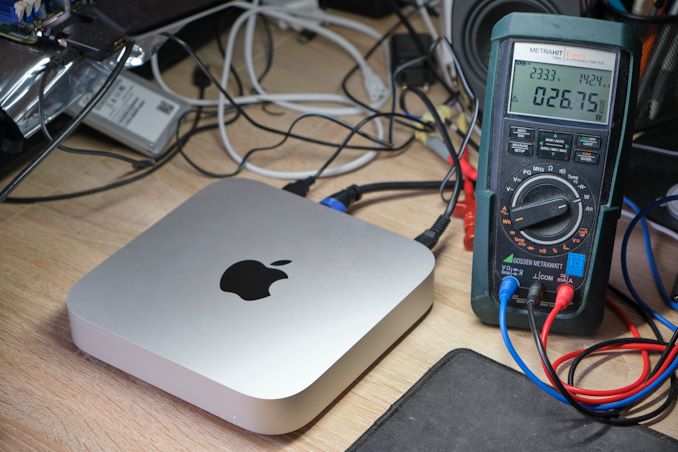The 2020 Mac Mini Unleashed: Putting Apple Silicon M1 To The Test
by Andrei Frumusanu on November 17, 2020 9:00 AM ESTConclusion & First Impressions
Today’s piece was less of a review on the new Mac mini as it was testing out Apple’s new M1 chip. We’ve had very little time with the device but hopefully were able to manage to showcase the key aspects of the new chip, and boy, it’s impressive.
For years now we’ve seen Apple’s custom CPU microarchitecture in A-series phone SoCs post impressive and repeated performance jumps generation after generation, and it today’s new Apple Silicon devices are essentially the culmination of the inevitable trajectory that Apple has been on.
In terms of power, the Apple M1 inside of the new Mac mini fills up a thermal budget up to around 20-24W from the SoC side. This is still clearly a low-power design, and Apple takes advantage of that to implement it into machines such as the now fan-less Macbook Air. We haven’t had opportunity to test that device yet, but we expect the same peak performance, although with more heavy throttling once the SoC saturates the heat dissipation of that design.
In the new Macbook Pro, we expect the M1 to showcase similar, if not identical performance to what we’ve seen on the new Mac mini. Frankly, I suspect Apple could have down-sized the Mini, although we don’t exactly now the internal layout of the piece as we weren’t allowed to disassemble it.
The performance of the new M1 in this “maximum performance” design with a small fan is outstandingly good. The M1 undisputedly outperforms the core performance of everything Intel has to offer, and battles it with AMD’s new Zen3, winning some, losing some. And in the mobile space in particular, there doesn’t seem to be an equivalent in either ST or MT performance – at least within the same power budgets.
What’s really important for the general public and Apple’s success is the fact that the performance of the M1 doesn’t feel any different than if you were using a very high-end Intel or AMD CPU. Apple achieving this in-house with their own design is a paradigm shift, and in the future will allow them to achieve a certain level of software-hardware vertical integration that just hasn’t been seen before and isn’t achieved yet by anybody else.
The software side of things already look good on day 1 due to Apple’s Rosetta2. Whilst the software doesn’t offer the best the hardware can offer, with time, as developers migrate their applications to native Apple Silicon support, the ecosystem will flourish. And in the meantime, the M1 is fast enough that it can absorb the performance hit from Rosetta2 and still deliver solid performance for all but the most CPU-critical x86 applications.
For developers, the Apple Silicon Macs also represent the very first full-fledged Arm machines on the market that have few-to-no compromises. This is a massive boost not just for Apple, but for the larger Arm ecosystem and the growing Arm cloud-computing business.
Overall, Apple hit it out of the park with the M1.











682 Comments
View All Comments
shadowii - Tuesday, November 17, 2020 - link
You're not sure because you must not have read the article. May I suggest decoupling your self-esteem from chip performance from companies that don't personally care about you?PhotinoBird - Tuesday, November 17, 2020 - link
This is literally Apple's first and lowest end chip. Like, this is the CPU they put in the laptop with no fan. AMD is certainly top of the heap here in a lot of ways, and that's great. But you can't deny that Apple's first kick at the can with their least powerful and least expensive chip is very impressive, delivering extremely high performance at a powerdraw that is simply unheard of right now in laptops.YesYesNo - Tuesday, November 17, 2020 - link
This is their highest end chip.nico_mach - Tuesday, November 17, 2020 - link
Well, that's one way of putting it, but it's clearly a first effort for this segment and shot across the bow of Intel. AMD at least has a chance to catch up, and isn't losing a customer over this. Whereas Intel just got blown up. They'll be selling off the splinters soon to maximize shareholder value - they've been quite cynically milking the platform and failing, a breakup is the next logical step.YesYesNo - Tuesday, November 17, 2020 - link
There is no way to know if this is the best they can do currently or if they are holding something back.I see no reason to consider what might come out from Apple, AMD or Intel compared to what is currently out.
hugi - Tuesday, November 17, 2020 - link
Apple is replacing the processors in their entire Mac lineup in the next 24 months. There will not be M1s in the Mac Pro.mdriftmeyer - Friday, November 20, 2020 - link
That's the plan but first they have several more Intel based products in the works to extend over the next three years. And if rumors were factual it is clear they know they can't replace the Mac Pro 218 core Xeon with any possible equivalent on their part with ARM, hence the Mac Pro Mini whispered about being half the size of the current Mac Pro.If they were smart they'd drop Xeon during the transition and go Zen 3.
jbelkin - Thursday, November 19, 2020 - link
They usually announce new products around CES so look for the next batch (iMac, MBP 16"? ... 12-16 Core??) in the next 3 months.Spunjji - Tuesday, November 17, 2020 - link
For now, yes. It very soon won't be.YesYesNo - Tuesday, November 17, 2020 - link
And when it isn't i will reconsider.